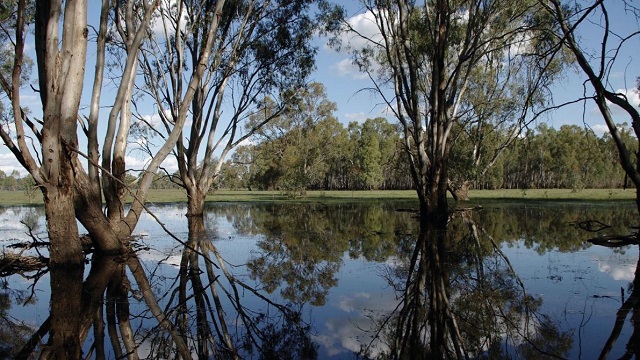Barmah National Park


Barmah National Park, together with the adjoining Millewa forest in New South Wales, forms the largest River Red Gum forest in the world. The complex ecology of the forest is closely linked to the Murray River and its flooding regime, creating a diverse natural habitat for a variety of wildlife, particularly waterbirds.
Barmah is a great spot for camping. Days can be easily filled with fishing, horse riding, bushwalking, swimming and canoeing. The park's tracks are excellent for both walking and cycling, while the sandy beaches and waters of nearby Ulupna Island are suitable for canoeing and fishing.
Ulupna Island is home to a vast number of native wildlife. An early morning or late afternoon visit to this region will not disappoint, with sightings of kangaroos and koalas virtually guaranteed. The island also contains many sandy river beaches, making it an ideal location for swimming, camping and picnics. Many bushwalking tracks allow you to fully enjoy the scenery.
Barmah State Park is a haven for wildlife, including eastern grey kangaroos, koalas and more than 220 species of birds.
Enjoying the Park
Walking
Yamyabuc Discovery Trail - 1.5km - 0.5 hours return
This self-guided walk begins at the Dharnya carpark and will introduce you to some of the natural and cultural features of the Barmah forest. The walk includes evidence of Aboriginal and European occupation, the Barmah muster yards and aspects of park management, forestry operations and water regulation.
Lakes Loop Track - 4km - 1.75 hours return
Begin this circular walk at the Dharnya carpark or join at the the Barmah Lakes campground, day visitor area or Rices Bridge. The walk passes through mature and regrowth River Red Gum trees past a number of Aboriginal oven (cooking) mounds. It skirts the edge of Barmah Lake, eventually reaching the Murray River and Broken Creek. The best time for this walk is summer and autumn.
The area has been home to the Yorta Yorta people for more than 40,000 years - the trail passes Aboriginal sacred sites including ancient kitchen middens, oven mounds and canoe trees - huge river red gums that supplied bark for Aboriginal canoes.
Broken Creek Loop Track - 3.5km - 1.5 hours return
This circular walk begins behind the Visitor Centre and skirts Dharnya swamp, a low area subject to seasonal flooding. Walk through River Red Gum and Grey Box woodland to Broken Creek. Continue downstream along Broken Creek where you can see pelicans, ducks, egrets and darters. There are a number of Aboriginal oven (cooking) mounds on the way to Rices Weir. See the fish ladder that allows fish to go back upstream past the weir. Return via Sandridge Track or continue on the Lakes Loop track to Dharnya.
Camping
Camping is popular along much of the 112km frontage to the Murray River. With its majestic River Red Gums, sandy beaches and a large variety of wildlife, the Murray provides the ideal backdrop for camping and a range of water-based activities. The Barmah Lakes area has toilets, fireplaces and tables. Dispersed camping is permitted elsewhere along the river, with basic facilities at Ulupna Island.
Boating and Canoeing
Imagine the peace and tranquility paddling around the backwaters, creeks and lagoons along the Murray River. There's so much to discover. By canoe or kayak you'll see the incredible wildlife and bushland surrounds from a whole new perspective.
Boating is also a popular past-time on the Murray River, Barmah Lakes and adjoining creeks. There are several boat launching areas.
Fishing
The Murray River provides excellent fishing opportunities, particularly for Murray Cod, Golden Perch, Cat Fish and Yabbies with many visitors returning time and time again to fish their favourite spot..
A NSW Freshwater Recreation Fishing Licence is required for the Murray River. A current Victorian Recreational Fishing Licence is required for fishing in waters south of the Murray River.
Swimming
Swimming can be enjoyed at the numerous sandy river bend beaches.
History
European settlement - The area was first explored in the late 1830s and settled soon after. Sheep and cattle were grazed throughout the region and the rich River Red Gum forest was harvested for timber. Paddle steamers on the Murray River were the key mode of transport and heavily used for wool and timber trade.
Evidence of past logging practices can be seen with old mill sites and equipment still visible. Eucalyptus extraction and charcoal production also occurred in the forest.
Access for Dogs:
Dogs and other pets are not permitted in Barmah National Park. They are permitted in Murray River Reserves, but must be kept under control.
How to get there
Barmah National Park lies along the Murray River between Barmah and Strathmerton, about 225km north of Melbourne. Major entry points are from Moira Lakes Road, Barmah-Picola Road and the Murray Valley Highway.
Note: Photos from Parks Victoria
Web Links
→ Barmah National Park (Parks Victoria)
→ Barmah National Park - Park note (PDF)









